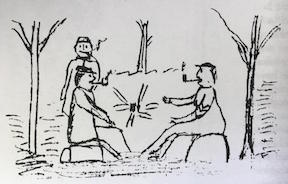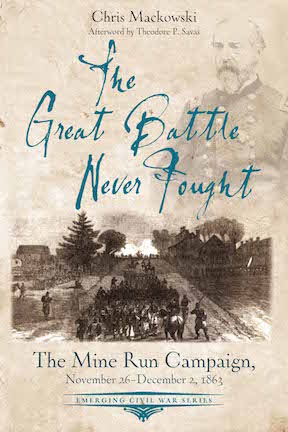The Evening Smoke and Armchair Generalling After Mine Run

On the evening of December 2, the Army of the Potomac settled back into its camps around Brandy Station and Culpeper, exactly where they’d departed from just a week earlier. The baffling—and frigid—events of the campaign weighed fresh on their minds. “How well we sat and talked over the events of the last few days and enjoyed our evening smoke,” said one armchair general, Austin Stearns of the 13th Massachusetts.
I’ve armchair-generalled the Mine Run Campaign quite a bit, too—not just over the past few days but the past few years (as well as in The Great Battle Never Fought). I thought I’d compile a collection of the articles I’ve written about the campaign in one convenient, easy-to-armchair-general list for your convenience and continued consideration:
I’ve organized past articles based on the date of the events discussed in each post.
Nov. 26
- Thanksgiving, 150 years ago (2013)
- Thanksgiving 1863: A “vivid contrast” between home and the front (2018)
- Meade After Mine Run on Grant After Chattanooga (2016)
Nov. 27
- The Mine Run Campaign Comes to Locust Grove (2017)
- Robinson’s Tavern Today (2018)
- A New Find for New Hope Church (VA) (2018)
- A Walk at Payne’s Farm (2015)
Nov. 28-29 (It looks like I need to do some writing about events on these two dates next year!)
Nov. 30
- A True “Legend” that “Perfectly Describes the Character of the Army of the Potomac” (2016)
- At the Center of Nothing, Meade’s Greatest Moment (2015)
- Deconstructing Meade’s Decision at Mine Run (2018)
Dec. 1
- From Lee’s Side of Mine Run (2018)
Dec. 2
* * *
And don’t forget our in-the-field perspectives from Mine Run as part of our Facebook LIVE broadcasts with the American Bettlefield Trust: Facebook LIVE from Payne’s Farm 155 (2018)
* * *
 My book on Mine Run, The Great Battle Never Fought, has been a long time in the making. Believe it or not, I thought back in 2012 that I would finally be getting started on the project after years of researching. Well, that didn’t quite work out! I’m grateful that I had the chance to finish the book at last, though. Here are a few posts about the book’s origins:
My book on Mine Run, The Great Battle Never Fought, has been a long time in the making. Believe it or not, I thought back in 2012 that I would finally be getting started on the project after years of researching. Well, that didn’t quite work out! I’m grateful that I had the chance to finish the book at last, though. Here are a few posts about the book’s origins:
- Morning at Mine Run (2012)
- The Great Battle and the Ghosting of Meade (2018)
- The Great Battle is Here (2018)
Chris –
A question for you – are any of the the defensive positions that Lee’s engineers constructed at Mine Run visible today? or are they all on private land?
I appreciate all of the articles you have posted.
Excellent post, Chris. Lee learned the folly of open field attacks at Gettysburg, and the offensive use of entrenchments at Mine Run. I really believe Lee’s greatest generalship occurred in 1864, when he retained a flexible response to Meade/Grant’s moves, and employed his engineering skills to the max. The North Anna and Cold Harbor positions were masterpieces of improvisation. His use of limited tactical counterattacks at Petersburg was masterful. All while his health was slowly deteriorating.